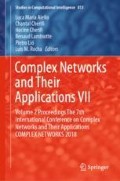Abstract
The emergence of social bots within online social networks (OSNs) to diffuse information at scale has given rise to many efforts to detect them. While methodologies employed to detect the evolving sophistication of bots continue to improve, much work can be done to characterize the impact of bots on communication networks. In this study, we present a framework to describe the pervasiveness and relative importance of participants recognized as bots in various OSN conversations. Specifically, we harvested over 30 million tweets from three major global events in 2016 (the U.S. Presidential Election, the Ukrainian Conflict and Turkish Political Censorship) and compared the conversational patterns of bots and humans within each event. We further examined the social network structure of each conversation to determine if bots exhibited any particular network influence, while also determining bot participation in key emergent network communities. The results showed that although participants recognized as social bots comprised only 0.28% of all OSN users in this study, they accounted for a significantly large portion of prominent centrality rankings across the three conversations. This includes the identification of individual bots as top-10 influencer nodes out of a total corpus consisting of more than 2.8 million nodes.
Access this chapter
Tax calculation will be finalised at checkout
Purchases are for personal use only
References
Lazer, D., et al.: The science of fake news. Science 359, 1094–1096 (2018)
Ferrara, E., Varol, O., Davis, C., Menczer, F., Flammini, A.: The rise of social bots. Commun. ACM 59(7), 96–104 (2016)
Subrahmanian, V., et al.: The DARPA Twitter bot challenge. Computer 49(6), 38–46 (2016)
Varol, O., Ferrara, E., Davis, C., Menczer, F., Flammini, A.: Online human-bot interactions: detection, estimation, and characterization. In: AAAI Web and Social Media, pp. 280–289 (2017)
Chavoshi, N., Hamooni, H., Mueen, A.: DeBot: Twitter bot detection via warped correlation. In: 2016 IEEE 16th International Conference on Data Mining (ICDM), pp. 817–822 (2016)
Chu, Z., Gianvecchio, S., Wang, H., Jajodia, S.: Detecting automation of Twitter accounts: are you a human, bot, or cyborg? IEEE Secur. Comput. 9(6), 811–824 (2012)
Davis, C.A., Varol, O., Ferrara, E., Flammini, A., Menczer, F.: BotOrNot: a system to evaluate social bots, pp. 273–274 (2016)
Stukal, D., Sanovich, S., Bonneau, R., Tucker, J.A.: Detecting bots on Russian political Twitter. Big Data 5, 310–324 (2017)
Abokhodair, N., Yoo, D., McDonald, D.W.: Dissecting a social botnet: growth, content and influence in Twitter. CSCW 2016, 839–851 (2015)
Kušen, E., Strembeck, M.: Why so emotional? An analysis of emotional bot-generated content on Twitter. COMPLEXIS 2018, 13–22 (2018)
Hegelich, S., Janetzko, D.: Are social bots on Twitter political actors? Empirical evidence from a Ukrainian social botnet. In: ICWSM, pp. 579–582 (2016)
Bessi, A., Ferrara, E.: Social bots distort the 2016 U.S. Presidential election online discussion. First Monday 21(11) (2016)
Forelle, M., Howard, P.N., Monroy-Hernández, A., Savage, S.: Political bots and the manipulation of public opinion in Venezuela. In: SSRN, pp. 1–8 (2015)
Howard, P.N., Kollanyi, B.: Bots, #StrongerIn, and #Brexit: Computational Propaganda during the UK-EU Referendum. SSRN (2016). URL: https://ssrn.com/abstract=2798311
Boshmaf, Y., Muslukhov, I., Beznosov, K., Ripeanu, M.: Design and analysis of a social botnet. Comput. Netw. 57, 556–578 (2013)
Howard, P.N., Woolley, S., Calo, R.: Algorithms, bots, and political communication in the US 2016 election. J. Inf. Technol. Polit. 15, 81–93 (2018)
Zhdanova, M., Orlova, D.: Computational Propaganda in Ukraine: Caught Between External Threats and Internal Challenges. COMPROP, Oxford, UK. Working Paper (2017)
Chavoshi, N., Hamooni, H., Mueen, A.: Temporal patterns in bot activities. In: 26th International Conference on World Wide Web, pp. 1601–1606 (2017)
Wasserman, S., Faust, K.: Social Network Analysis: Methods and Applications. Cambridge University Press, Cambridge (1994)
Bonacich, P.: Some unique properties of eigenvector centrality. Soc. Netw. 29(4), 555–564 (2007)
Freeman, L.C.: A set of measures of centrality based on betweenness. Sociometry 40(1), 35–41 (1977)
Valente, T.W., Coronges, K., Lakon, C., Costenbader, E.: How correlated are network centrality measures? Connections 28(1), 16–26 (2008)
Girvan, M., Newman, M.E.: Community structure in social and biological networks. Proc. Natl. Acad. Sci. 99(12), 7821–7826 (2002)
Blondel, V.D., Guillaume, J-L., Lambiotte, R., Lefebvre, E.: Fast unfolding of communities in large networks. J. Stat. Mech. 2008(10) (2008)
Cha, M., Haddadi, H., Benevenuto, F., Gummadi, K.P.: Measuring user influence in Twitter: the million follower fallacy. In: Proceedings of the Fourth International AAAI Conference on Weblogs and Social Media (ICWSM 2010), pp. 10–17 (2010)
Tufekci, Z.: Big questions for social media big data: representativeness, validity and other methodological pitfalls. In 8th International Conference on Weblogs and Social Media (ICWSM 2014), pp. 505–514 (2014)
Acknowledgments
Special thanks to Nikan Chavoshi from New Mexico State University for support and access to DeBot. This research was partially supported through funding from the Seth Bonder Foundation.
Author information
Authors and Affiliations
Corresponding author
Editor information
Editors and Affiliations
Rights and permissions
Copyright information
© 2019 Springer Nature Switzerland AG
About this paper
Cite this paper
Schuchard, R., Crooks, A., Stefanidis, A., Croitoru, A. (2019). Bots in Nets: Empirical Comparative Analysis of Bot Evidence in Social Networks. In: Aiello, L., Cherifi, C., Cherifi, H., Lambiotte, R., Lió, P., Rocha, L. (eds) Complex Networks and Their Applications VII. COMPLEX NETWORKS 2018. Studies in Computational Intelligence, vol 813. Springer, Cham. https://doi.org/10.1007/978-3-030-05414-4_34
Download citation
DOI: https://doi.org/10.1007/978-3-030-05414-4_34
Published:
Publisher Name: Springer, Cham
Print ISBN: 978-3-030-05413-7
Online ISBN: 978-3-030-05414-4
eBook Packages: Intelligent Technologies and RoboticsIntelligent Technologies and Robotics (R0)

